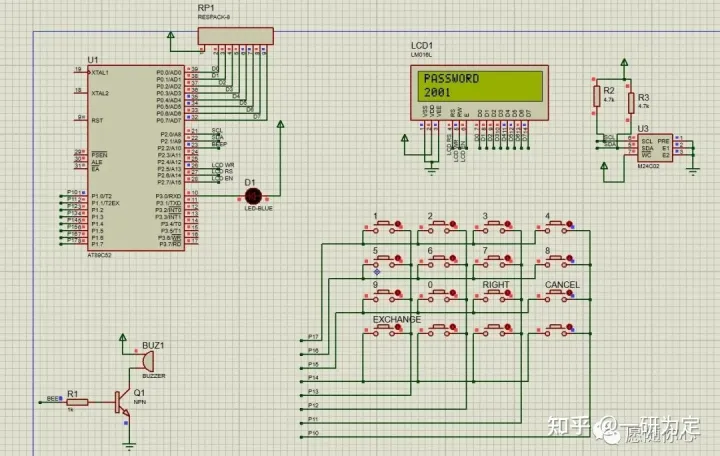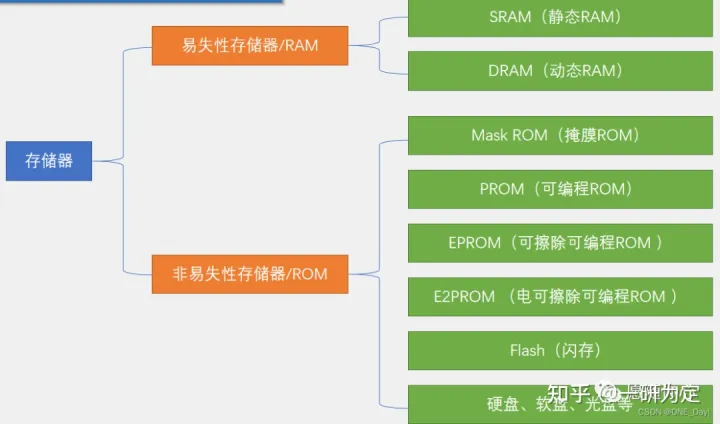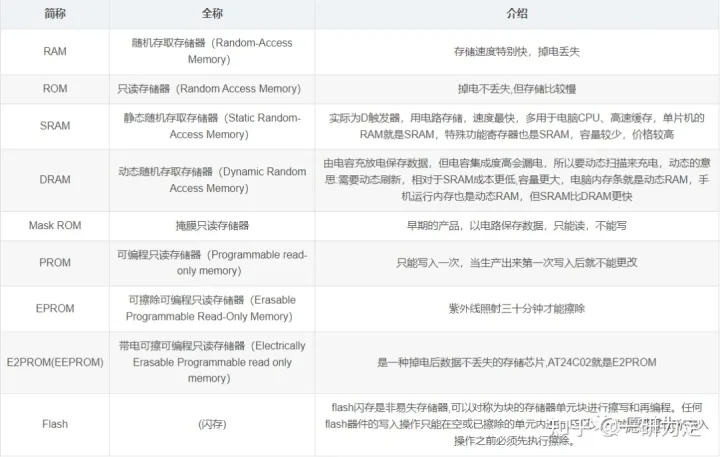具体功能的实现:
按下不同的按键,在LCD1602显示屏中可以出现不同的数字密码,如果输入错误,会显示ERR,反之显示ON;如果密码输错3次,则蜂鸣器报警30s同时在此期间无法输入密码。按键的功能有重置密码,取消,确认三种功能。
器件:AT89C51,排阻,LCD1602,若干电阻,电源,按键,蜂鸣器,三极管
Proteus仿真原理图:

知识介绍:
①存储器介绍:


存储器主要芯片AT24C02:
AT24C02是一个2K位串行CMOS E2PROM, 内部含有256个8位字节,CATALYST公司的先进CMOS技术实质上减少了器件的功耗。AT24C02有一个16字节页写缓冲器。该器件通过IIC总线接口进行操作,有一个专门的写保护功能。
②为什么蜂鸣器要接NPN晶体管?
加NPN型三极管进行驱动,因为单片机的引脚驱动能力有限,蜂鸣器的功率比较大,所以需要通过三极管来驱动。
③为什么P0口接上拉电阻?
因为P0口是准双向口,即是开漏输出的,当P0口作为并行口使用时,只能输出低电平,不能输出高电平,需要接一个上拉电阻才能输出高电平。
主要代码(C语言)KEIL5实现:
主函数代码:
#include #include "Delay.h" #include "LCD1602.h" #include "MatrixKey.h" #include "Beep.h" #include "AT24C02.h" unsigned char KeyNum; unsigned int password,count; unsigned int scount; unsigned int rightpass ; sbit led = P3^0; sbit P22 = P2^2; void main() { P22 = 0; rightpass = 2001; LCD_Init(); while(1) { KeyNum = MatrixKey(); LCD_ShowString(1,1,"PASSWORD"); if(KeyNum) { if(KeyNum <= 10) { led = 1; if(count < 4) { password*=10; password += KeyNum % 10; count++; } LCD_ShowNum(2,1,password,4); } if(KeyNum == 13) { rightpass = password; password = 0; count = 0; LCD_ShowNum(2,1,password,4); } if(KeyNum == 11) { if(password == rightpass) { LCD_ShowString(1,14,"ON "); led = 0; password = 0; count = 0; LCD_ShowNum(2,1,password,4); }else{ LCD_ShowString(1,14,"ERR"); scount++; if(scount == 3) { int i = 60; while(i--) { Beep(); } Delay(30000); scount = 0; } password = 0; count = 0; LCD_ShowNum(2,1,password,4); } } if(KeyNum == 12) { password = 0; count = 0; LCD_ShowNum(2,1,password,4); } } } }










